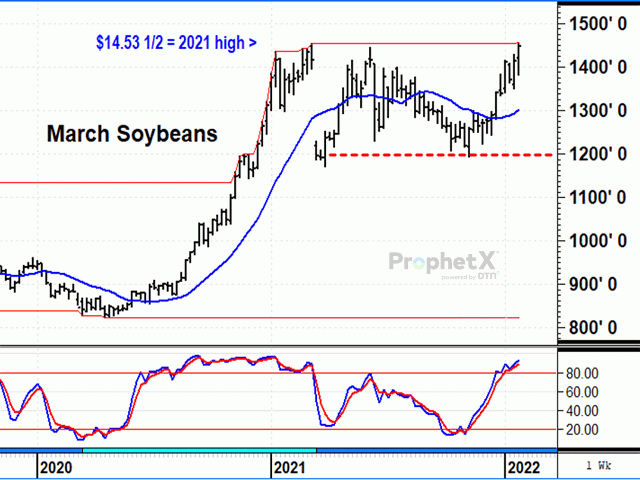Todd's Take
Soybean Prices Challenge Old Highs
There is no question, the market that has had the most bullish surprises in the first four months of 2021-22 has been soybeans. And the kicker is this same market was looking convincingly bearish back in early November (see "Soybean Bears Emerge ... " at https://www.dtnpf.com/…).
From the Sept. 30 Grain Stocks report to early November, USDA nearly doubled its estimate of U.S. ending soybean stocks in 2021-22 to 340 million bushels (mb), while China's soybean and meal prices broke lower and March soybean oil prices fell below their 100-day average.
Along with that, soybean prices in Brazil were showing no signs of stress and were actually making new lows. Brazil's soybean crops were successfully planted early in the fall and were enjoying good crop conditions. Looking back, it is odd how all those seemingly unrelated factors turned bearish at roughly the same time.
Fast forward to this week and we see a completely different set of market factors driving prices higher. The first bullish surprise emerged in December when soybean meal prices unexpectedly started trading higher. The market had known about a shortage of synthetic lysine for several months, but a sudden urgency of demand developed for cash meal prices in December. Meal prices were driven higher and enhanced the returns at soybean crush plants.
Also in December, murmurings started about dry weather conditions in southern Brazil. At first, the affected area appeared limited to Rio Grande do Sul, but by late December and early January it became apparent that other neighboring states and Argentina were also being affected. Brazil's soybean prices started perking up in January and added further support to U.S. soybean prices.
Throughout much of December, soybean oil prices kept a low profile, but that changed in late December and early January, encouraged by new highs in canola and palm oil. The Tuesday after Martin Luther King Jr. Day is when things really started picking up for soybean oil.
P[L1] D[0x0] M[300x250] OOP[F] ADUNIT[] T[]
Heightened concerns about Russian troops near the Ukrainian border started showing up in grain and crude oil prices. For soybean oil, bullish influence came from crude oil's impact on biodiesel prices as well as from sunflower seed oil. Ukraine is the world's largest exporter of sunflower seed oil and any disruption to supplies in a potential conflict would have bullish ramifications for all the major vegetable oils.
Having soybean meal and soybean oil prices both experiencing good demand at the same time is an unusual occurrence for soybeans. Typically, the combined value of soybean meal and oil from crushing beans would be roughly $1.00 or $1.50 above the cost of the soybeans. Based on March futures prices, the premium has been running above $2.00 since October and closed at $2.57 on Thursday.
USDA's weekly report of crush values in Illinois showed an even higher theoretical difference. On Thursday, Jan. 27, USDA showed one bushel of $14.12 soybeans in central Illinois could produce $17.22 of meal and oil, a difference of $3.09 per bushel. The week before, USDA's crush premium was $3.93 a bushel.
The one part of demand that has not gone well for soybeans so far in 2021-22 is export sales. As of Jan. 20, U.S. sales and shipments of soybeans totaled 1.622 billion bushels (bb), down 24% from a year ago. China's soybean purchases are down 27% from a year ago. Thursday morning's weekly report showed decent soybean sales of 37.7 mb, but with Brazil's harvest underway, we probably can't expect that level much longer.
The problem for the next seven months is that Brazil's soybeans are already cheaper than U.S. soybeans, so adding to the current total of U.S. sales is going to be a tough sell. There is a possibility Brazil's soybean crop has been damaged more than USDA's 5.11 bb (139.0 mmt) estimate, but even if it is, the U.S. is not likely to see sales pick up until the late summer or fall.
On Thursday, Jan. 27, March soybeans posted a new closing high of $14.48 1/4, just shy of the $14.53 1/2 high posted by the March contract in 2021. Technically, it will be very important to see how soybean prices behave near the old highs and at least some resistance is possible.
Soybeans trading above $14 that USDA says have a national average production cost of roughly $10 per bushel are very attractive prices for producer selling. It is difficult to know if or by how much soybean prices might trade higher if they break above the old highs. The two most important factors are apt to be South American weather and the standoff in Ukraine.
I don't know if Russia's President Vladimir Putin actually intends to invade Ukraine or not. It seems he has plenty of ways of causing problems within Ukraine without attracting international reprisals. Currently, President Putin seems to be in good shape just as things are. He is getting a lot of attention; he is under no pressure to move troops and crude oil prices continue to rise from the uncertainty of the world not knowing what he'll do next.
It's a difficult call, but for those reasons, it is possible that the conflict in Ukraine and the current soybean rally may both have further to go.
**
Comments above are for educational purposes only and are not meant as specific trade recommendations. The buying and selling of grain or grain futures or options involve substantial risk and are not suitable for everyone.
Todd Hultman can be reached at Todd.Hultman@dtn.com
Follow him on Twitter @ToddHultman1
(c) Copyright 2022 DTN, LLC. All rights reserved.




